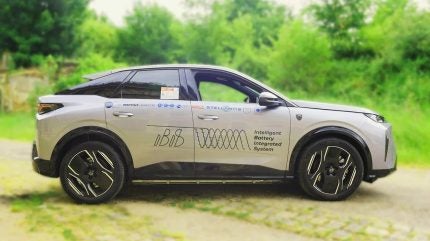
Stellantis, in collaboration with TotalEnergies subsidiary Saft, has introduced a prototype vehicle equipped with the Intelligent Battery Integrated System (IBIS) technology.
The system, developed through a French collaborative research project, is designed to provide a “sustainable and cost-effective” solution for energy storage and electric conversion in both mobile and stationary applications.

Discover B2B Marketing That Performs
Combine business intelligence and editorial excellence to reach engaged professionals across 36 leading media platforms.
The project has entered its second phase as of June 2025, with support from the French Government via the France 2030 initiative.
Its focus is now on real-world testing under typical driving conditions, which could lead to the integration of IBIS technology into Stellantis’ production vehicles by the end of the decade.
The vehicle in question is a new Peugeot E-3008, which is the first fully functional battery electric vehicle (BEV) to be fitted with the IBIS technology.
Stellantis noted that this prototype is based on the STLA Medium platform and is the culmination of design, modelling, and simulation efforts by Stellantis and Saft, with contributions from E2-CAD, Sherpa Engineering, and French research institutions.
An initial IBIS demonstrator has been in operation since mid-2022 for stationary applications, during which it has validated essential technical concepts and resulted in various patents.
The IBIS technology “reimagines” the electric powertrain by incorporating inverter and charger functionalities within the battery itself, according to the automotive major.
The approach applies to various battery chemistries and is designed to support both alternating current (AC) and direct current (DC).
It can supply electric energy directly to the motor or grid, while also powering the vehicle’s 12V network and auxiliary systems.
The integration of IBIS technology is said to have demonstrated an energy efficiency improvement of up to 10% during the worldwide harmonised light vehicles test cycle (WLTC) and a 15% power increase, achieving 172 kW compared to the standard 150 kW, all with the same battery size.
Additionally, the vehicle’s weight is reduced by approximately 40 kg, and up to 17 litres of volume is freed, which can be utilised for improved aerodynamics and design flexibility.
Early results have also shown a 15% decrease in charging time.
Furthermore, the IBIS system allows for the second-life battery reuse in both automotive and stationary applications.
Stellantis chief engineering and technology officer Ned Curic said:
“This project reflects our belief that simplification is innovation. By rethinking and simplifying the electric powertrain architecture, we are making it lighter, more efficient, and more cost-effective.”
In July 2025, Stellantis announced a partnership with driver interaction platform 4screen to incorporate real-time, location-based digital services into its portfolio of vehicle brands.






